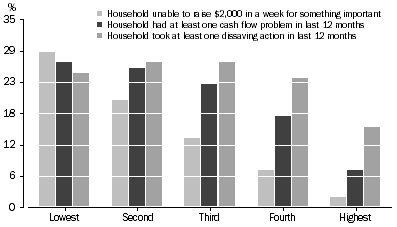FINANCIAL STRESS
The financial stress indicators and income data collected in the GSS can provide insights into the economic wellbeing of various groups in the Australian community. Some of the financial stress questions required objective answers, but the interpretation of the responses as indicators of financial stress are subjective. Other questions are inherently subjective in nature. While some of the indicators (such as seeking assistance from welfare/community organisations) appear to be more severe than others, such as 'could not pay electricity, gas or telephone bills on time', it is difficult to rank or weight them in order to derive a single measure of intensity of financial stress.
In 2010 19% of adults reported that their household had one or more cash flow problems in the 12 months prior to interview, slightly higher than in 2006 (18%). In 2010, more people reported that their household was unable to pay bills on time, such as electricity, gas, telephone or car registration and that they had to pawn something to raise cash than in 2006. In 2010 a higher proportion of people also reported that their household undertook one or more dissaving actions (23%) compared to 2006 (19%). This was mainly attributable to more households drawing down on their accumulated savings or term deposits (table 46).
Differing household composition was associated with different levels of financial stress. For example:
- of the 709,900 adults in one family lone parent households with dependent children, 41% reported that they lived in households that could not raise $2,000 in an emergency, compared with 11% of the 4,977,400 adults in one family couple households with dependent children;
- 47% of adults living in one family lone parent households with dependent children reported that their households had at least one cash flow problem in the previous 12 months (21% for adults in couple households with dependent children); and
- 39% of adults living in one family lone parent households reported that their households took at least one dissaving action in the 12 months prior to the survey (27% for those in couple households with dependent children) (table 45).
The reporting of financial stress does not necessarily imply that a household has low income. Some high income households reported financial stressors. Nevertheless, comparing the income characteristics of those experiencing financial stress shows that those in the lowest income quintile (the bottom 20% of people ranked by equivalised household income) were: less likely than people in other households to be able to raise money quickly for something important; more likely to report that their household had experienced cash flow problems in the last 12 months; and more likely than people in the top income quintile to report that their household had taken a dissaving action in the past 12 months (table 46 and graph 8.1). These patterns and their magnitudes were similar between 2010 and 2006 except for the proportion of adults reporting that their households had taken at least one dissaving action in the 12 months prior to the 2010 interview. In 2010 these rates were higher across all income quintiles than in 2006.
8.1 Selected financial stress indicators, By equivalised household gross weekly income quintiles

 Print Page
Print Page
 Print All
Print All